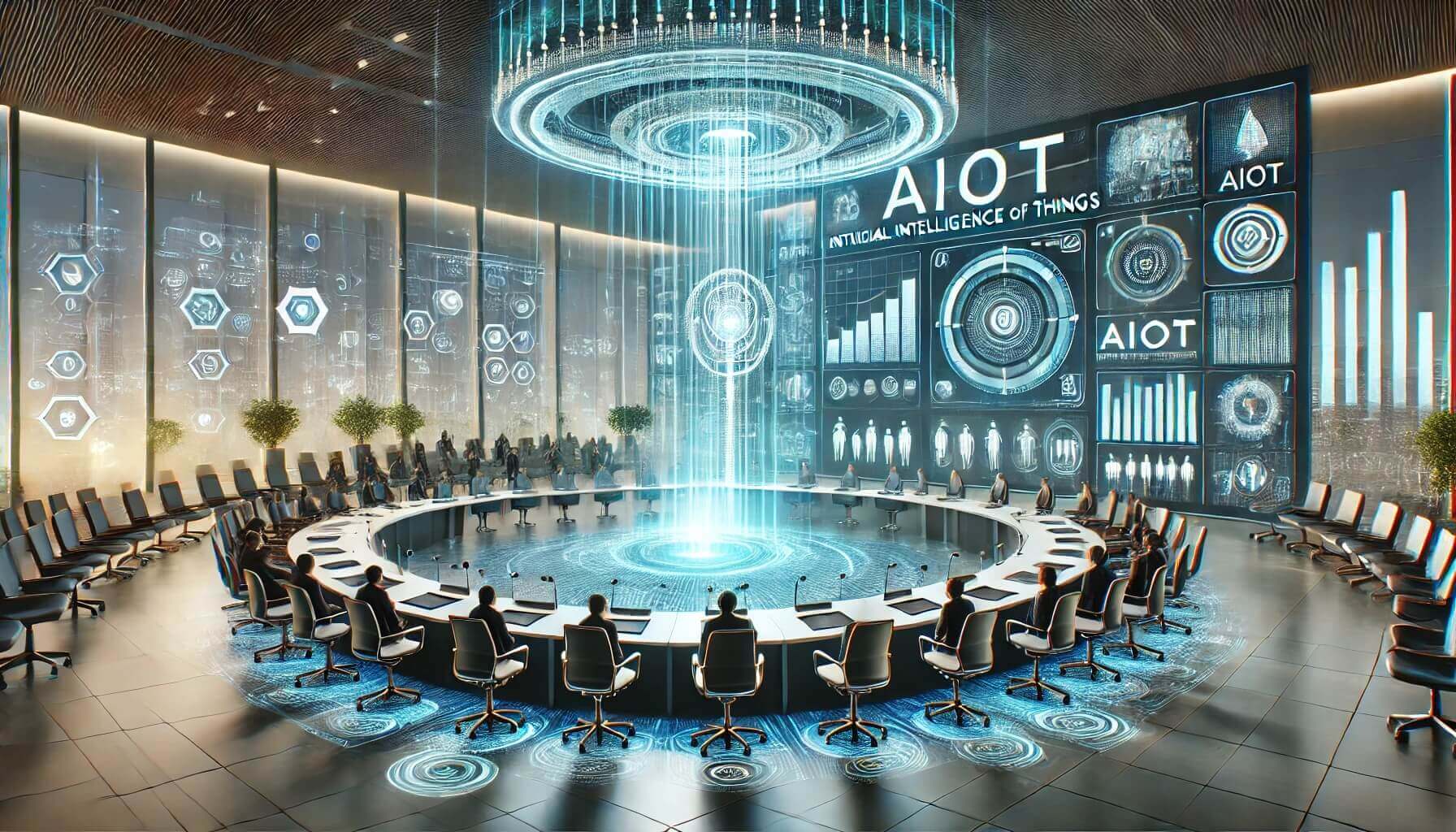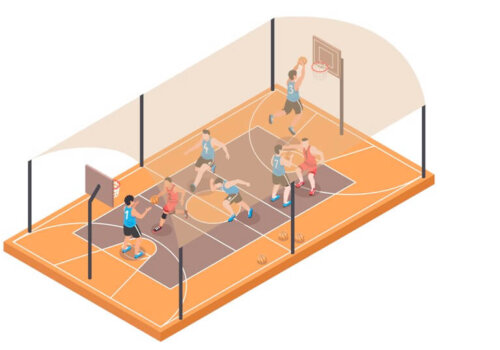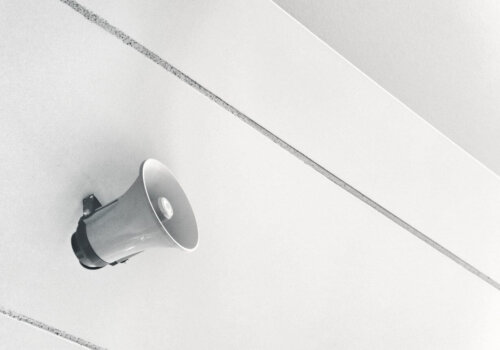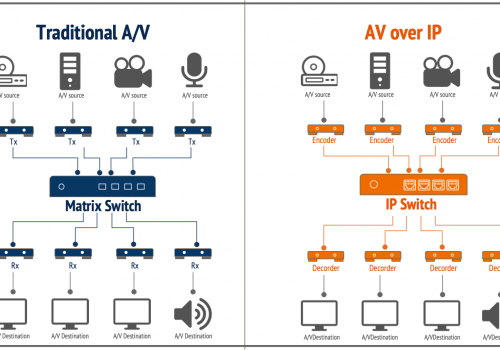
As digitalization and smart management demands continue to rise, BXB Electronics is accelerating its transformation from AVIoT (AV over IoT) to AIoT (AI-powered IoT). By integrating AI-driven data analytics with IoT’s real-time connectivity, BXB is strengthening its position in intelligent space management. This evolution aims to enhance automation, optimize meeting and learning environments, and deliver a more seamless, efficient user experience with reduced manual intervention.
AIoT technology has the potential to revolutionize Smart Meeting Rooms by enabling adaptive microphone sensitivity and audio distribution based on participant count and sound dynamics. This ensures clear, evenly distributed audio across the space. Additionally, AIoT-driven energy management can analyze real-time data to automate lighting, air conditioning, and environmental controls, improving energy efficiency while reducing operational costs. Unlike traditional AVIoT, which primarily focuses on AV signal transmission and control, AIoT introduces intelligent data processing and autonomous decision-making. BXB is actively exploring AI edge computing and algorithm integration, allowing systems to self-optimize audio and video configurations in real time for smarter, more responsive management.
BXB is currently advancing AIoT applications in Smart Classrooms, corporate offices, and large-scale event venues. By delivering highly integrated intelligent solutions, BXB aims to help clients achieve smarter, more competitive operations. As one of the key drivers of digital transformation, AIoT is shaping the future of efficiency and sustainability. With continuous investment in R&D and innovation, BXB Electronics is poised to empower businesses with next-generation smart solutions, leading the way in intelligent and future-ready development.
Advantages and Limitations of AVIoT
AVIoT (Audio-Visual Internet of Things) has proven its value in smart meeting rooms, smart classrooms, and other interactive environments. By integrating AV equipment with network systems, AVIoT delivers high-quality audiovisual experiences and stable digital management. For example, in meeting spaces, AVIoT enables synchronized control of audio systems, cameras, and projectors over a network, enhancing both professionalism and interactivity. However, as market demands evolve toward smarter and more adaptive solutions, AVIoT faces several limitations:
- Limited Intelligent Data Processing – While AVIoT can collect AV data, it lacks advanced analytics and AI-driven adjustment, making it unable to dynamically optimize settings based on environmental changes.
- Restricted Automation Capabilities – AVIoT relies heavily on manual control, limiting its ability to enable fully automated smart space management, especially in dynamic environments.
- Low Cross-Device Collaboration – AVIoT struggles with seamless integration between multiple devices, leading to delays in real-time synchronization and reduced system flexibility.
How AIoT Overcomes AVIoT Limitations?
BXB Electronics is actively exploring how AIoT (AI-powered IoT) can break through the limitations of AVIoT (Audio-Visual IoT) by combining AI-driven intelligent decision-making with IoT’s real-time connectivity. This integration unlocks a new era of smarter, more efficient space management solutions.
- AI-Driven Smart Decision-Making
AIoT brings real-time analytics to AV systems, automating settings based on environmental needs. In smart meeting rooms, AIoT can analyze attendee numbers and voice distribution to automatically adjust microphone sensitivity and speaker output, ensuring optimal audio coverage. For example, BXB’s tabletop conference microphone precisely detects human voices, filtering out background noise and automatically muting when not in use, eliminating manual intervention. Additionally, AI-powered video tracking with BXB’s VT-725 controller recognizes speaker positions, adjusting camera angles and focus dynamically. This automated tracking and intelligent scene switching enhance remote collaboration experiences while reducing operational complexity. - High Automation & Real-Time Adaptability
AIoT automates device configuration and optimization, minimizing manual adjustments in meeting rooms and classrooms. In smart classrooms, AIoT can automatically switch display modes and audio settings based on lesson types, improving teaching efficiency and adaptability. AI-driven video processing can adjust projection ratios based on content or dynamically track instructors and students with AI-powered cameras. Integrated with VT-725’s PTZ camera control, the system auto-tracks speakers, ensuring they remain in focus. When two speakers are active, the system automatically switches to split-screen mode, delivering a smooth and professional visual experience. - Scalable Across Multiple Smart Applications
AIoT extends beyond AV, integrating seamlessly into smart offices and campuses, while avoiding unnecessary IT and OT infrastructure upgrades. AI-driven visual analytics enable attendance detection, participant engagement tracking, and even real-time speech-to-text transcription and auto-generated notes. BXB is also developing AI-powered meeting transcript generation using microphone audio, which will soon integrate automated AI-based summarization to create structured meeting notes. - Edge Computing for Faster Response & Lower Latency
To enhance real-time performance while reducing cloud dependency and transmission delays, BXB is leveraging edge computing. Processing data closer to the device level significantly reduces response time and improves interactive efficiency. For video applications, edge computing enables faster image recognition, instantly detecting speakers and auto-adjusting camera focus for smoother, low-latency video conferencing. BXB’s VDM Networked AV Distribution Solution utilizes multi-node matrix encoders and decoders to optimize video rendering, maximizing the advantages of edge computing in AV data processing.
The transition from AVIoT to AIoT represents a major leap in intelligent space management. By merging AI’s advanced analytics with IoT’s connectivity, BXB is pioneering the next generation of smart automation. As the demand for intelligent space management continues to grow, AIoT is poised to become the backbone of future smart environments—enhancing efficiency, automation, and decision-making for businesses worldwide.
How Do AI and IoT Work Together?
AIoT (Artificial Intelligence + Internet of Things) is an advanced smart solution that combines AI’s deep learning and data analysis capabilities with IoT’s real-time connectivity. By integrating AI-powered intelligence into IoT devices, AIoT enhances real-time decision-making and automation, enabling smarter and more efficient management. While IoT primarily focuses on data collection and transmission through sensors and connected devices, data alone is not enough to meet modern smart management demands. AI is introduced to analyze vast amounts of real-time data, using pattern recognition, anomaly detection, and predictive analytics to automate system adjustments, ultimately optimizing user experience and resource efficiency.
With AI and IoT working together, AI can analyze IoT-generated data in real time and automatically optimize system settings based on insights. Smart Climate Control – AIoT can adjust temperature and airflow using indoor sensor data, creating a comfortable environment while reducing energy consumption. AI-Powered Image Recognition – AIoT enables real-time space monitoring, analyzing occupancy and movement patterns to dynamically adjust lighting and climate settings based on the number of people in a room. Enhanced Security & Automation – Smart cameras can perform facial recognition for access control in meetings and classrooms, ensuring a secure environment. Additionally, AI-driven camera tracking can automatically adjust angles and focus on speakers, delivering an optimized visual experience for conferences and lectures. By seamlessly integrating AI into IoT systems, AIoT unlocks new levels of automation, efficiency, and intelligence, making it the foundation for next-generation smart environments.
Real-World Application: How AIoT Automates Smart Meeting Rooms
AIoT is revolutionizing smart meeting rooms by introducing high-level automation and intelligence. Through the seamless integration of AI and IoT, meeting room systems can self-manage and enhance collaboration experiences. AI-Powered Speaker Tracking – Facial recognition technology automatically detects the speaker’s position, dynamically adjusting camera angles and zoom levels to ensure clear visibility for all participants. Adaptive Audio Optimization – AI analyzes microphone input and speaker placement, automatically adjusting volume and gain to ensure even, crystal-clear sound distribution across the room. Smart Environment Control – AIoT automatically regulates lighting and climate settings based on the meeting phase. For instance, during presentations, the system dims the lights to emphasize the projection screen, while adjusting air conditioning for optimal comfort. Automated Scheduling & Resource Management – BXB’s Smart Meeting System syncs with corporate calendars, auto-reserving rooms and equipment based on scheduled meetings. Occupancy sensors track actual usage, preventing space waste and maximizing efficiency. This transformation upgrades meeting rooms from simple AV management to fully automated collaboration hubs. By enhancing management efficiency and optimizing user experience, AIoT-powered smart meeting rooms are driving businesses toward intelligent and streamlined operations.
5 Key AIoT Advantages: Driving Business Transformation
AIoT technology is redefining digital transformation and smart management, offering intelligent control, automation, and cross-industry applications. With its ability to streamline operations, optimize efficiency, and support innovation, AIoT enables businesses to stay ahead in a rapidly evolving market while advancing toward sustainability and smarter decision-making.
- Enhanced Efficiency & Cost Optimization
AIoT automates data-driven decision-making, reducing operational costs and boosting efficiency. By analyzing real-time data, AIoT optimizes resource allocation, minimizes energy waste, and reduces manual intervention. Smart Offices – AIoT automatically adjusts lighting and air conditioning to balance energy savings and workplace comfort. Smart Space Utilization – AI-powered image recognition tracks room occupancy, dynamically optimizing meeting room and classroom usage to maximize efficiency. Seamless Meeting Management – Integrated with a USB desktop keypad, users can instantly switch AV settings, change room layouts, or launch files with a single touch, creating a customized smart meeting experience. - Intelligent Control & Seamless Integration
AIoT bridges AI-powered intelligence with IoT connectivity, enabling centralized automation across multiple systems. Unified Platform Management – Businesses can control video conferencing, AV, and environmental systems through a single interface, ensuring smooth, scenario-based adaptation. Cross-Brand & Multi-Protocol Compatibility – AIoT eliminates system silos, supporting seamless integration of diverse AV and control systems. Enhanced Video Quality & Stability – AI-powered image processing ensures high-resolution video conferencing with minimal lag.
BXB SC-100 Smart AV Controller – Users can manage all devices and power settings via a web-based control panel, accessible from a computer or tablet. - Superior User Experience
AIoT transforms user interaction by automating smart environments and enhancing usability. Automated Camera & Audio Adjustments – AIoT detects speaker positions, dynamically adjusting camera angles and audio settings to ensure optimal visibility and sound clarity. Personalized Meeting Settings – AIoT fine-tunes lighting, volume, and AV configurations based on the meeting type. One-Touch Controls – The BXB USB desktop keypad enables users to instantly power devices on/off or open specific files, enhancing ease of use. - Predictive Maintenance & Real-Time Analytics
With AI-driven diagnostics, AIoT monitors device health in real-time, enabling predictive maintenance and preventing unexpected downtime. Sensor-Driven Fault Detection – AI-powered algorithms detect potential system failures, sending automated maintenance alerts to reduce disruptions and extend equipment lifespan. - Limitless Cross-Industry Applications
AIoT extends beyond meetings and education, transforming smart cities, healthcare, and manufacturing. Smart Cities – AIoT monitors traffic flow in real-time, optimizing traffic signals to reduce congestion. Manufacturing – Automated quality control and production monitoring enhance efficiency and product reliability. BXB MT-2 Multimedia Timer Player – Beyond multimedia scheduling, this device integrates government Open Data to display real-time weather, air quality, and earthquake alerts, providing enhanced safety and environmental awareness.
How AIoT is Revolutionizing Smart Spaces
AIoT is driving a transformative upgrade in smart spaces through breakthrough innovation. By combining automation with data-driven intelligence, AIoT enhances system connectivity, enabling real-time monitoring, precise analytics, and self-adjusting management. This intelligent networked ecosystem empowers industries with: More efficient operations, Optimized resource allocation, Proactive, automated management, Additionally, AIoT enhances interactivity and user experiences, accelerating the transition toward digitized, intelligent environments—reshaping the future of smart spaces.
- Smart Meeting Rooms: Intelligent Video Tracking & Audio Optimization
AIoT seamlessly integrates artificial intelligence with IoT connectivity, enabling comprehensive automation and intelligent control. Through a unified management platform, businesses can consolidate multiple systems—video conferencing, audio, and environmental controls—into a single interface that automatically adapts to different meeting scenarios. Additionally, AIoT supports cross-brand and multi-protocol compatibility, preventing system fragmentation and ensuring seamless device integration. Advanced image processing technology enhances video quality and stability, delivering clear and smooth remote conferencing experiences. For example, the BXB SC-100 Smart AV IoT Controller allows users to manage all in-room devices and power settings through a single web-based interface on a computer or tablet, making smart meeting room control effortless and efficient. - Smart Classrooms: Personalized Learning & Enhanced Teaching Quality
AIoT is revolutionizing education by enabling personalized learning experiences and data-driven teaching strategies. Smart classrooms leverage AIoT technology to adapt lesson content and presentation methods based on student progress and real-time interaction data. By seamlessly integrating AV systems with learning management platforms, teachers can receive instant student feedback and adjust teaching strategies dynamically, leading to more effective and engaging lessons. To simplify device management, the BXB SC-100 Smart AV IoT Controller allows users to control all classroom AV and power systems through a single web-based interface on a computer or tablet. This all-in-one solution not only enhances ease of use but also optimizes the overall efficiency of smart classrooms, creating a more interactive and adaptmore interactive and adaptive learning environment. - Smart Office: Automated Environmental Control for a High-Performance Workplace
AIoT-powered smart offices enhance efficiency, comfort, and resource optimization through automated management. By leveraging real-time data analysis, AIoT systems can dynamically adjust lighting and air conditioning, creating an optimal work environment for employees. Additionally, AIoT enables automated meeting room reservations, monitors space utilization, and uses occupancy sensors to optimize office layouts—maximizing resource efficiency while reducing energy consumption. With the BXB MT-2 Multimedia Timer Player, smart offices can also integrate government Open Data, displaying real-time weather updates, air quality levels, and earthquake alerts. This ensures comprehensive environmental monitoring and safety, making the workplace smarter, more efficient, and more responsive to employees’ needs. - Smart Retail: Data-Driven Operations for a New Level of Efficiency
In the retail industry, AIoT-powered automation and real-time data analytics are revolutionizing store operations and customer experiences. Optimized Product Displays & Promotions – AIoT analyzes foot traffic and sales data to dynamically adjust product placement and promotional strategies based on customer behavior. Intelligent Inventory Management – Smart sensors monitor shelf stock and trigger real-time restocking alerts, ensuring optimal product availability. Seamless Digital Device Integration – The BXB SC-100 Smart AV IoT Controller enables store managers to control digital signage, lighting, and in-store systems from a single interface via computer or tablet. This integrated approach not only streamlines retail operations but also elevates data-driven decision-making, creating a more efficient and customer-centric shopping environment.
Six Key Strategies for Driving AIoT Transformation
By implementing these six strategic approaches, AIoT becomes a powerful engine for digital transformation, helping businesses: Enhance operational efficiency, Increase automation, Optimize resource allocation. With real-time data insights and intelligent decision-making, AIoT not only boosts market competitiveness and innovation potential but also minimizes operational risks and streamlines workflows. Through deep AIoT integration, businesses can adapt more flexibly to market shifts, ensuring long-term leadership in the smart era while creating sustainable business value.
- Data Services: The Core of AIoT Efficiency
AIoT excels in real-time, high-efficiency data management and analysis. Using smart sensors and edge computing, it can collect and process massive data streams instantly, while cloud-based platforms centralize management for seamless accessibility. Additionally, AI-powered image analysis enables pattern recognition through surveillance footage, allowing businesses to monitor space usage and generate visualized reports for data-driven decision-making. - Asset Management: Maximizing Performance & ROI
One of the most critical AIoT applications is intelligent asset monitoring. By utilizing real-time tracking and predictive analytics, companies can gain full visibility into asset usage and performance. AIoT can automatically detect equipment abnormalities, triggering proactive maintenance workflows to reduce unplanned downtime, extend asset lifespan, and maximize return on investment. - Immersive Applications: AIoT + AR/VR for Next-Level Engagement
Integrating AIoT with AR/VR technology revolutionizes interactive experiences in smart exhibitions and education. Through 3D image modeling and virtual tour technology, AIoT enhances engagement, accessibility, and learning efficiency. For example, AI-driven image recognition can deliver real-time visual translations and smart content annotations, making immersive applications even more intelligent and dynamic, ultimately optimizing training and educational experiences. - Process Optimization: Automating Data Collection & Analysis
AIoT streamlines enterprise operations and production workflows by automating data collection and analysis. Smart warehouse management systems, automatically track inventory levels and trigger restocking alerts, preventing overstocking and supply shortages. AI-powered image analysis monitors production environments, ensuring equipment operates smoothly while minimizing human errors and downtime. - Next-Generation User Interfaces: Intuitive & Hands-Free Control
AIoT enhances human-machine interaction with voice recognition, gesture control, and biometric authentication, making interactions more natural and intuitive. In smart meeting rooms, users can adjust lighting, audio, and projection systems with voice commands, enabling seamless automation and an enhanced meeting experience. - Industrial Automation: AIoT-Powered Smart Manufacturing
AIoT is revolutionizing industrial automation, driving smart factories and next-gen production systems. Automated sensors and edge computing enable real-time production monitoring, automated quality control, and predictive maintenance. Sensors on production lines detect anomalies instantly, allowing AI-powered systems to trigger alerts and initiate repair protocols before disruptions occur.
How Can Businesses Overcome AIoT Transformation Challenges?
- System Integration & Cost-Effective AIoT Upgrades
Implementing AIoT technology requires a highly integrated software and hardware ecosystem, often presenting technical complexities and high upgrade costs. To mitigate these challenges, businesses should adopt modular, highly compatible AIoT platforms, enabling gradual upgrades rather than expensive large-scale replacements. Key strategies for cost optimization include: Modular AIoT Deployment – Upgrade systems incrementally to manage costs and reduce disruptions. Edge Computing Integration – Minimize reliance on costly cloud resources by processing data locally. AI-Powered Image Analysis – Monitor equipment in real-time to detect mechanical issues through visual data, reducing the need for manual inspections and lowering maintenance costs. By optimizing cost structures and streamlining system upgrades, businesses can maximize AIoT adoption benefits while ensuring financial efficiency. - The Importance of Data Security & Privacy Protection in AIoT
As AIoT systems process vast amounts of real-time data, ensuring data security and privacy has become a critical challenge. Businesses must implement multi-layered security measures, including: End-to-End Data Encryption – Protects sensitive data during transmission and storage. Edge Computing Data Isolation – Reduces risks by processing data locally instead of relying solely on cloud services. Strict Access Control – Ensures only authorized personnel can access critical information. To maintain high security standards, companies should comply with global regulations such as GDPR and ISO 27001, ensuring secure data transmission and storage. For AI-powered imaging applications, businesses can integrate facial recognition with AI-driven image blurring techniques to safeguard personal privacy while ensuring regulatory compliance. - Maximizing ROI with AIoT
To fully unlock the business potential of AIoT, companies should focus on data-driven decision-making and operational automation. Predictive Maintenance & Real-Time Monitoring – AIoT minimizes unplanned downtime and extends equipment lifespan, reducing operational disruptions. Optimized Efficiency & Resource Utilization – AIoT dynamically adjusts energy consumption and resource allocation, maximizing productivity and cost savings. AI-Powered Imaging for Production Optimization – AIoT analyzes visual data to streamline manufacturing workflows and implements image recognition for quality control, ensuring products meet industry standards and enhancing overall ROI.
While AIoT adoption comes with challenges such as system integration, high costs, and data security concerns, businesses can successfully navigate these obstacles by implementing strategic solutions: Modular Upgrades – Gradual AIoT integration reduces disruptions and costs, allowing for scalable transformation. Enhanced Data Protection – Strengthening cybersecurity and encryption ensures secure AIoT operations. Data-Driven Optimization – Leveraging AI-powered analytics maximizes resource utilization and boosts productivity. By adopting these strategies, businesses can overcome technical barriers, drive efficiency, and maintain a competitive edge in an increasingly smart and digital-driven landscape.
From AVIoT to AIoT: BXB Electronics Leading the Smart Transformation
As the demand for digitalization and intelligent management continues to grow, BXB Electronics is actively advancing from AVIoT (AV over IoT) to AIoT (AI-powered IoT), exploring the full potential of smart transformation solutions. Through cutting-edge research and innovation, BXB aims to enhance automation, optimize smart space management, and redefine user experiences in meeting and learning environments. By integrating AI-driven data analytics with IoT’s real-time connectivity, BXB envisions a future of seamless automation that simplifies operations, reduces manual intervention, and delivers more stable, efficient system management.
AIoT technology is set to revolutionize smart meeting management by: Auto-adjusting microphone sensitivity and speaker output based on participant count and voice distribution, ensuring clear, evenly distributed sound. Optimizing energy efficiency—using real-time data analysis and automated controls, AIoT can intelligently adjust lighting, air conditioning, and environmental systems, reducing operational costs. Unlike traditional AVIoT, which focuses on AV signal transmission and control, AIoT emphasizes smart data processing and autonomous decision-making. BXB Electronics is exploring AI edge computing and algorithm integration, enabling real-time optimization of audio and video configurations for smarter, more intuitive space management.
BXB is continuously expanding AIoT applications in smart classrooms, corporate offices, and large-scale event venues, delivering highly integrated smart solutions to help businesses achieve greater intelligence and competitiveness. As AIoT becomes a key driver of digital transformation, BXB’s commitment to R&D and innovation positions it as a leader in shaping the future of smart, efficient, and sustainable business operations.
Connect with BXB Today – Step into the Future of Smart Meetings & Smart Learning! Whether you’re a business leader or an education expert, BXB’s AIoT solutions are designed to empower your transformation. From enhancing meeting efficiency to revolutionizing teaching methods, we provide tailor-made upgrades that keep you ahead of the curve. Join us now and unlock limitless possibilities—let’s elevate your business and learning experiences to new heights!
BXB Electronics – Breaking Communication Barriers, Leading the Future with Innovative Technology
Committed to the mission of “Using Tech to Break Barriers.” BXB Electronics excels in providing cutting-edge Audio-Visual IoT integrated solutions for “Smart Offices” and “Smart Classrooms.” These solutions enhance communication and learning efficiency, and BXB’s innovation and design excellence have been recognized with prestigious industry awards, including the German iF Design Award and Japan’s Good Design Award. As an internationally renowned BXB brand, BXB Electronics markets its products in over 50 countries and leads the domestic market in conference systems, campus broadcasting systems, and public broadcasting systems. Trusted by a wide range of clients from publicly listed companies to government agencies and over 400 schools, BXB products are a top choice globally. Established in 1991, BXB Electronics strives to achieve its vision of “Harmonizing the World,” continually pursuing excellence and sustainable development. Our product line includes video conferencing systems, IP multimedia distribution systems, broadcasting systems, and IP live streaming solutions, extensively used in educational institutions, corporate sectors, and government agencies. We provide comprehensive solutions including Smart Meeting Rooms, conference room planning, Smart Classrooms, future classroom configurations, and optimized audiovisual classroom setups.
For more information about BXB Electronics, including product details and latest updates, visit our official social media platforms.




